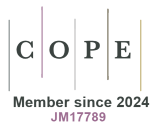Most read articles by the same author(s)
- Matteo Ruggeri, Francesca Romana Rolli, Cost per response/remission in biologics available in Italy for the treatment of TNF-α inhibitors-naïve patients with ulcerative colitis , Global and Regional Health Technology Assessment: Vol. 6 No. 1 (2019): January-December 2019
- Andrea Marcellusi, Chiara Bini, Barbara Muzii, Samira Soudani, Alexia Kieffer, Matthieu Beuvelet, Elena Bozzola, Fabio Midulla, Eugenio Baraldi, Paolo Bonanni, Sara Boccalini, Luigi Orfeo, Economic and clinical burden associated with respiratory syncytial virus and impact of universal immunization with nirsevimab in Italy , Global and Regional Health Technology Assessment: Vol. 12 No. 1 (2025): January-December 2025
- Filippo Rumi, Michele Basile, Americo Cicchetti, Cost-effectiveness and budget impact analysis for high dose quadrivalent influenza vaccine in the Italian elderly population , Global and Regional Health Technology Assessment: Vol. 8 No. 1 (2021): January-December 2021
- Michele Basile, Ilaria Valentini, Roberto Attanasio, Renato Cozzi, Agnese Persichetti, Irene Samperi, Alessandro Scoppola, Renata Simona Auriemma, Ernesto De Menis, Felice Esposito, Emanuele Ferrante, Giuseppe Iatì, Diego Mazzatenta, Maurizio Poggi, Roberta Rudà, Fabio Tortora, Fabio Cruciani, Zuzana Mitrova, Rosella Saulle, Simona Vecchi, Paolo Cappabianca, Agostino Paoletta, Alessandro Bozzao, Marco Caputo, Francesco Doglietto, Francesco Ferraù, Andrea Gerardo Lania, Stefano Laureti, Stefano Lello, Davide Locatelli, Pietro Maffei, Giuseppe Minniti, Alessandro Peri, Chiara Ruini, Fabio Settanni, Antonio Silvani, Nadia Veronese, Franco Grimaldi, Enrico Papini, Americo Cicchetti, A pharmacoeconomic analysis from Italian guidelines for the management of prolactinomas , Global and Regional Health Technology Assessment: Vol. 11 No. 1: January-December 2024
- Francesco Saverio Mennini, Martina Paoletti, Chiara Bini, Andrea Marcellusi, Marco Falcone, Massimo Andreoni, Cost-utility analysis of ceftolozane/tazobactam vs meropenem in patients with hospital-acquired pneumonia (HABP) or ventilator-associated pneumonia (VABP) , Global and Regional Health Technology Assessment: Vol. 9 No. 1 (2022): January-December 2022
- Andrea Marcellusi, Angela Ragonese, Andrea Marinozzi, Alberto Bortolami, Sara Mucherino, Carolina Moreno, Amalia Antenori, Matteo Ferrario, Claudia Simonelli, Matteo Zanuzzi, Marco Cicoira, Ruggero Lasala, Francesco Russoniello, Francesco Attanasio, Caterina Donati, Chiara Roni, Fabrizio Gemmi, Francesco Saverio Mennini, Pierluigi Russo, Giovanna Scroccaro, PierLuigi Canonico, Good practices for the development of budget impact models at regional level , Global and Regional Health Technology Assessment: Vol. 10 No. 1 (2023): January-December 2023
- Michele Basile, Lorenzo Somaini, Americo Cicchetti, Budget Impact Analysis of prolonged-release buprenorphine depot-formulation for the management of patients affected by opioid use disorder , Global and Regional Health Technology Assessment: Vol. 8 No. 1 (2021): January-December 2021
- Michela Bobini, Eugenio Di Brino, Americo Cicchetti, Towards a Green Health Technology Assessment: embedding Life Cycle Assessment for sustainable choices , Global and Regional Health Technology Assessment: Vol. 12 No. 1 (2025): January-December 2025
- Andrea Marcellusi, Paola Raimondo, Carlotta Galeone, Pier Luigi Canonico, Time to market access in Italy: duration of the P&R process for rare disease drugs , Global and Regional Health Technology Assessment: Vol. 10 No. 1 (2023): January-December 2023
- Martina Paoletti, Andrea Marcellusi, Joe Yang, Francesco Saverio Mennini, Cost-effectiveness of IMI/CIL/REL for the treatment of carbapenem non-susceptible Gram-negative bacterial infections , Global and Regional Health Technology Assessment: Vol. 10 No. 1 (2023): January-December 2023









